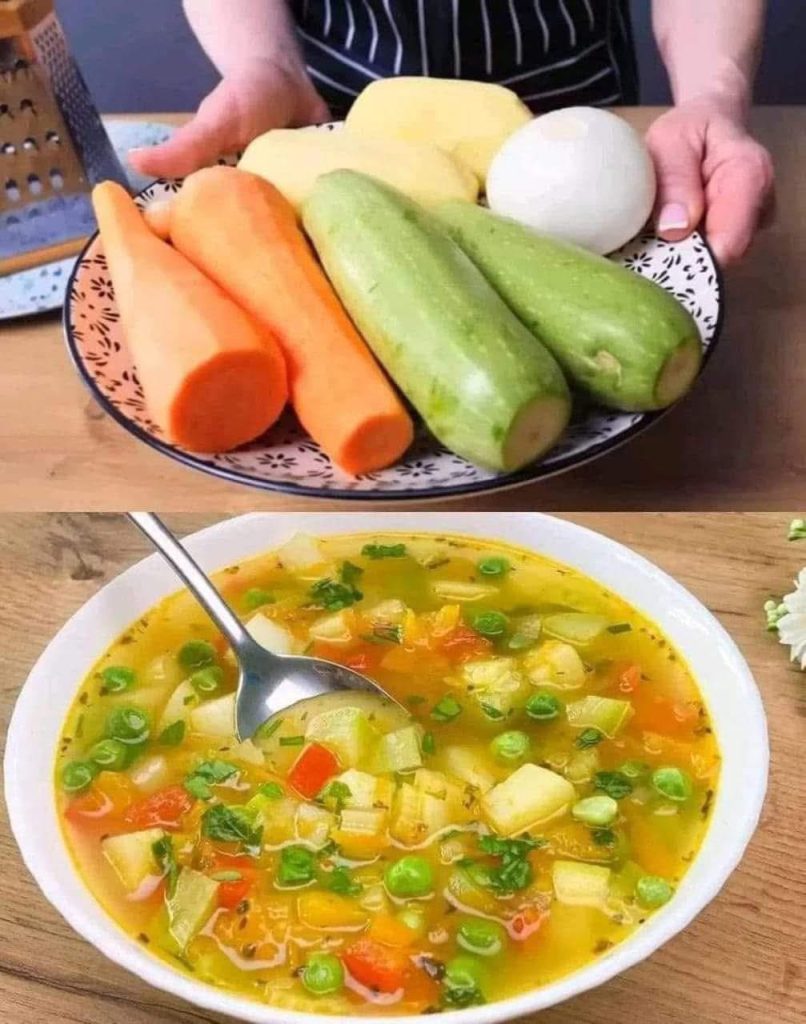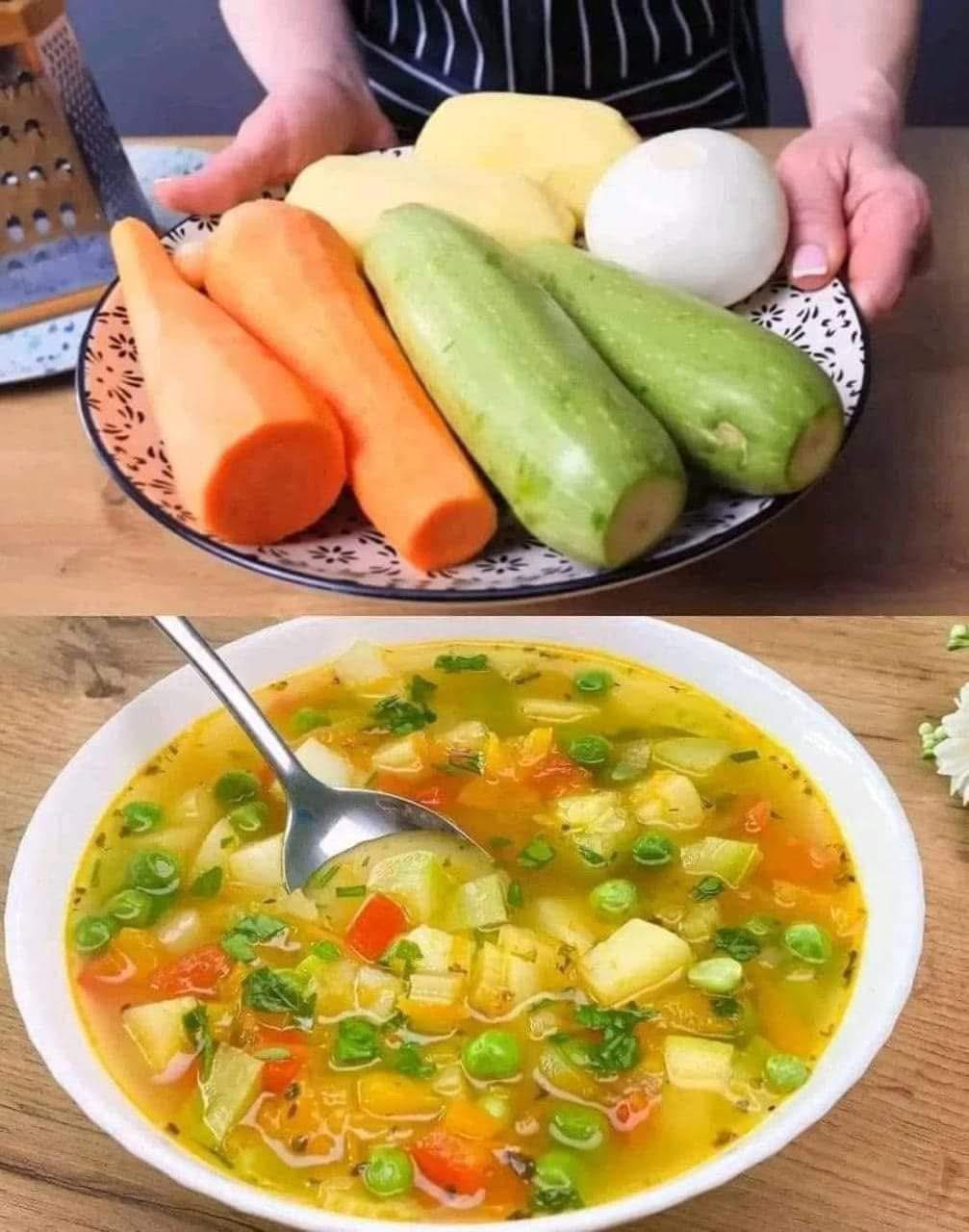Hearty Vegetable Soup

A warm and comforting bowl of vegetable soup is perfect for any season. Packed with fresh ingredients like carrots, zucchini, potatoes, and onions, this soup is not only nutritious but also bursting with flavor. Whether you’re looking for a light meal or a side dish, this hearty vegetable soup is an excellent choice.
History of Vegetable Soup
Vegetable soup has been a staple in many cultures for centuries. Early civilizations used whatever vegetables were available to create simple, nourishing broths. From the classic French potage to the Italian minestrone, every region has its unique take on vegetable soup. Historically, it was a dish for peasants due to its affordability, but today, it is loved by people of all backgrounds for its versatility and health benefits
Vegetable soup has been a cornerstone of human cuisine for millennia, evolving across different cultures and time periods. Its history reflects the adaptability and resourcefulness of people in utilizing available ingredients to create nourishing meals.
Ancient Origins
The concept of boiling vegetables to create a hearty broth dates back to ancient civilizations. Early humans likely combined various edible plants and roots in boiling water, laying the foundation for what we now recognize as vegetable soup. In ancient Rome, a dish called pulte was common, consisting of spelt flour cooked in salt water with added vegetables. This simple porridge-like preparation highlights the early use of grains and vegetables in soups. cite turn0search17
Medieval Developments
During the Middle Ages, vegetable soups became more diverse, incorporating a wider range of locally grown produce. In Italy, for instance, minestrone emerged as a thick vegetable soup, traditionally made without meat and varying widely based on available ingredients. This dish exemplifies the regional adaptations of vegetable soup, reflecting local tastes and agricultural practices. cite turn0search17
Cultural Variations
Across the globe, different cultures have developed their own versions of vegetable soup, each with unique ingredients and significance:
- Gazpacho: Originating in the southern regions of the Iberian Peninsula, gazpacho is a cold soup made of raw, blended vegetables. It’s widely consumed in Spain and Portugal, especially during the hot summer months. cite turn0search18
- Soup Joumou: A traditional Haitian squash soup, soup joumou is rich in history and symbolizes Haitian independence and freedom. On January 1, 1804, Haiti became the first Black republic after a successful revolution against French colonization, leading to the creation of soup joumou as a celebration of their liberation. cite turn0news14
Modern Times
Today, vegetable soup remains a dietary staple worldwide, appreciated for its versatility, nutritional value, and comforting qualities. It can be found in countless variations, from simple broths to complex stews, and continues to evolve with contemporary culinary trends.
In summary, the history of vegetable soup is a testament to human ingenuity and the universal desire for wholesome, satisfying food. Its enduring presence in our diets underscores its importance across cultures and generations.
Ingredients
Main Ingredients:
- 2 medium carrots, diced
- 2 zucchini, diced
- 2 potatoes, diced
- 1 large onion, chopped
- 1/2 cup green peas (fresh or frozen)
- 1 red bell pepper, diced
- 2 cloves garlic, minced
- 1 tomato, chopped
- 6 cups vegetable broth or water
- 2 tbsp olive oil
- 1 tsp salt (adjust to taste)
- 1/2 tsp black pepper
- 1/2 tsp turmeric (optional, for color and health benefits)
- 1/2 tsp dried basil or oregano
- 1/4 tsp red chili flakes (optional, for spice)
- Fresh parsley or cilantro, chopped (for garnish)
Instructions
Step 1: Prepare the Vegetables
- Wash and peel the carrots, potatoes, and onion.
- Chop all the vegetables into small, even-sized pieces for even cooking.
- Mince the garlic and set aside.
Step 2: Sauté the Aromatics
- Heat olive oil in a large pot over medium heat.
- Add chopped onions and sauté for 2-3 minutes until translucent.
- Stir in minced garlic and cook for another minute until fragrant.
Step 3: Cook the Vegetables
- Add the diced carrots, potatoes, and zucchini to the pot. Stir well.
- Pour in the vegetable broth and bring to a gentle boil.
- Reduce heat to low and let it simmer for 10 minutes.
Step 4: Add Seasoning & More Vegetables
- Stir in the chopped tomato, bell pepper, green peas, and all seasonings (salt, pepper, turmeric, basil, and chili flakes).
- Cover and cook for another 10-15 minutes until all the vegetables are tender.
Step 5: Finishing Touches
- Taste and adjust seasoning if needed.
- Garnish with fresh parsley or cilantro.
- Serve hot and enjoy!
Health Benefits of Vegetable Soup
- Rich in vitamins and minerals: Carrots provide vitamin A, potatoes give energy, and zucchini is loaded with antioxidants.
- Low in calories, high in fiber: Helps with digestion and weight management.
- Boosts immunity: Garlic, onions, and turmeric have antibacterial and anti-inflammatory properties.
- Keeps you hydrated: The broth replenishes fluids, making it perfect for staying hydrated.
Health Benefits of Hearty Vegetable Soup
This Hearty Vegetable Soup isn’t just comforting and delicious—it’s packed with nutrients that support overall health. Here’s why this soup deserves a regular spot on your table:
1. Boosts Immunity
- Garlic & Onion: Rich in antioxidants and antibacterial properties that help strengthen the immune system.
- Carrots & Bell Peppers: High in vitamin C and beta-carotene, which boost immune function and protect against infections.
2. Supports Digestion & Gut Health
- High in Fiber: Ingredients like carrots, zucchini, and potatoes provide dietary fiber, which promotes healthy digestion and prevents constipation.
- Hydrating & Light: The broth keeps you hydrated and soothes the stomach, making it ideal for those recovering from illness.
3. Aids in Weight Loss & Management
- Low-Calorie & Filling: This soup is naturally low in calories but high in fiber, helping you feel full longer without overeating.
- No Processed Ingredients: Unlike canned soups, this homemade version avoids preservatives and excess sodium.
4. Heart-Healthy
- Olive Oil: Contains heart-healthy monounsaturated fats that help reduce bad cholesterol (LDL).
- Vegetables: Rich in potassium and antioxidants, which support heart health and regulate blood pressure.
5. Provides Essential Vitamins & Minerals
- Carrots & Zucchini: Loaded with vitamin A for eye health and skin protection.
- Potatoes & Peas: Good sources of vitamin B6, iron, and magnesium, which support energy production and brain function.
- Tomatoes: Contain lycopene, an antioxidant known for reducing inflammation and protecting against chronic diseases.
6. Anti-Inflammatory Benefits
- Turmeric: Contains curcumin, a powerful compound known for its anti-inflammatory and pain-relieving properties.
- Garlic & Onions: Help reduce inflammation and protect against oxidative stress.
7. Supports Detox & Hydration
- High Water Content: Helps flush out toxins and keeps the body hydrated.
- Alkalizing Effect: Many vegetables in this soup help balance pH levels and reduce acidity in the body.
8. Budget-Friendly & Sustainable
- Uses simple, affordable ingredients that are widely available.
- Can be made with leftover vegetables, reducing food waste.
- Perfect for meal prep—store and reheat for quick, nutritious meals.
This vegetable soup is a powerhouse of nutrition, flavor, and health benefits. Whether you’re looking to lose weight, boost immunity, improve digestion, or simply enjoy a delicious, nourishing meal, this soup is a fantastic choice. Plus, it’s easy to make, budget-friendly, and perfect for all ages!
Would you like any additional variations or tips for customization?
Nutritional Information (Per Serving)
- Calories: ~120 kcal
- Carbohydrates: 22g
- Protein: 4g
- Fat: 3g
- Fiber: 5g
- Vitamin A: 90% DV
- Vitamin C: 50% DV
- Iron: 10% DV
The nutritional content of a hearty vegetable soup can vary based on the specific ingredients and preparation methods used. However, to provide a general idea, here’s an approximate nutritional breakdown per serving (about 1 cup or 275 grams):
| Nutrient | Amount per Serving |
|---|---|
| Calories | ~80-100 kcal |
| Protein | 2.8-4.1 g |
| Total Fat | 1.0-1.1 g |
| Carbohydrates | 14.1-14.6 g |
| Sugars | 5.5-6.6 g |
| Dietary Fiber | 4.7 g |
| Sodium | 810-985 mg |
These values are derived from various sources, including Pilpel Fine Foods cite turn0search 2 and Darikay cite turn0search 3 Please note that actual nutritional values can vary depending on the specific vegetables and quantities used in your recipe.
To obtain the most accurate nutritional information for your homemade soup, consider using a nutrition calculator or app where you can input your exact ingredients and their amounts.
Would you like assistance with calculating the nutrition for your specific recipe or any other information
Lovers of Vegetable Soup
This soup is loved by vegetarians, vegans, and health-conscious eaters. It is an excellent meal prep option and is often enjoyed by families worldwide. Even picky eaters appreciate its mild yet flavorful taste.
Conclusion
This hearty vegetable soup is a simple yet fulfilling dish that showcases the beauty of fresh vegetables. It’s easy to make, budget-friendly, and customizable to your preferences. Whether you’re serving it as a starter, a light meal, or a side dish, it will always leave you feeling warm and satisfied. Try it today and enjoy a bowl full of goodness!
